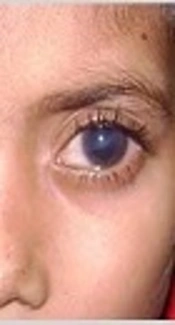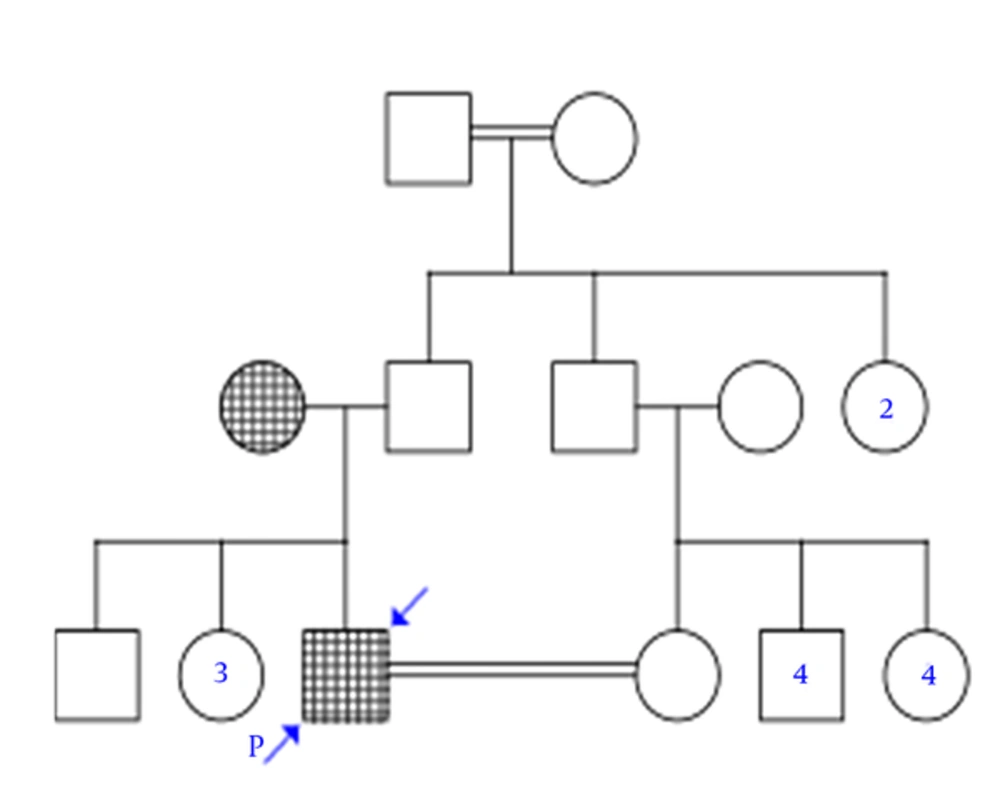1. Introduction
Nowadays, there is growing interest in genetic counseling to prevent disorders. Genetic counseling, especially in family marriages, plays an important role to prevent genetic disorders. In such marriages, defective genes frequently manifest diseases with autosomal recessive mode.
Primary congenital glaucoma (PCG) (OMIM 231300) is a disease with clinical and genetic heterogeneity; the incidence of PCG is geographically and ethnically variable. In familial cases, PCG is usually autosomal recessive. Glaucoma is a group of disorders that disrupt the eye’s optic nerve and leads to blindness if left untreated. It is the cause of 15% of blindness cases, and also the second leading cause of blindness. In addition, PCG is an inherited ocular disorder with common signs including a particular pattern of visual field loss and degeneration of the optic nerve (1) caused by apoptosis of retinal ganglion cells (2). Therefore, irreversible vision loss can be the result of disorder of aqueous outflow, increased intraocular pressure (IOP), and optic nerve damage. The disease occurs in the neonatal or early infant period with symptoms of expand of the globe, opacification of the cornea, and breaks in descemet membrane (3). In 80% of the cases, it is bilateral and more than 80% of cases occur within the first year of life. For the most common cause of PCG, three different loci are mapped for its (4) mutations in cytochrome P450 (CYP1B1; GLC3A) (5) reported in different ethnic backgrounds (6). PCG is the most common type for 55% of primary pediatric glaucoma. Its expression and penetrance vary from 40% to 100%. Studies identified that prevalence of PCG varies among ethnic populations extending from 1 in 10000 - 20000 in the Western people (7) to 1 in 2500 and 1 in 1250 in the Saudi Arabian people (8) and Gypsy community of Slovakia (7), respectively. In the Indian state of Andhra Pradesh, the prevalence is 1 in 3300 (9). In a study on the epidemiology of glaucoma in Iranian population in Yazd city, 4.4% of the studied individuals were affected with glaucoma, also this research revealed that 1.6% of individuals had high tension primary open angle glaucoma (POAG), 1.6% with normal tension POAG, and 0.4% of them had primary angle closure glaucoma (PACG), pseudo exfoliation glaucoma (PEXG), and other types of secondary glaucoma. It is revealed that cytochrome P450 1B1 (CYP1B1) is the cause of PCG in the majority of Iranian patients and many different CYP1B1 mutations are present among them. The origin of most mutations in the Iranians is inherited as identical by descent (IBD); they also have the same mutations in other populations. The four most prevalent mutations detected among the Iranians are p.G61E, p.R390H, p.R469W, and p.R368H. They constitute 51% of the Iranian CYP1B1 alleles studied and 76.2% of the mutated CYP1B1 alleles observed (10). PCG occurs both in sporadic and familial patterns. In familial cases, inheritance is usually autosomal recessive, sometimes associated with incomplete penetrance (6). Pseudo - dominant inheritance is also reported (11). More than 40 different mutations are reported in the entire coding region of CYP1B1 gene (12) and genetic heterogeneity varies within the population. High homogeneity reveals the higher frequency of inbreeding in the population. The current study mentioned an example of genetic counseling case in Iran that a client couple had first - cousin marriage and were demanding for pre pregnancy consultation, but the husband was unaware of his treated genetic disease in adulthood. Baseless and superstitious ideas about babies, diseases, and denial of their illness by parents cause the history of genetic disorders, especially the treated congenital form, remain hidden. When a person does not have any information about his/her inherited disease in adulthood, how he/she can do necessary preventive actions for marriage and childbearing? thus, the person does not perform necessary actions to prevent the transmission of disease to the next generation. The certified counselor or physician performing the counseling should investigate surgery reasons and its description about individuals with therapeutic or plastic surgery history in childhood.
2. Case Presentation
An Iranian nationality couple of Bakhtiari tribe with the first cousin marriage was demanding for pre - pregnancy consultation. In the early stages, there was no history of genetic disease at their pedigree. When they were asked about disease history since childhood up to now, they said the husband’s eyes were damaged at the age of three months using kohl with matchstick, and due to this reason, he had an eye surgery. While After more investigations it was distinguished that his surgery was due to primary congenital glaucoma. Also, it was specified that the husband’s mother used eye drops and was under glaucoma treatment periods. Blood samples were collected from the subject and his parents. It was at first necessary to examine the most common gene (CYP1B1) and in case of negative result, the rest of common genes were also checked. Peripheral blood lymphocytes were collected from the subject and his parents. After DNA extracting, CYP1B1 gene was amplified by the polymerase chain reaction (PCR), sequenced using Sanger technique, and examined to control the subjects and parents to detect the mutations causing the disease.
3. Discussion
Results of experiments using PCR sequencing method for CYP1B1 gene showed the husband and his mother were compound heterozygous for these gene mutations. Therefore, the wife was checked to identify that she is carrier for this damaged codons in CYP1B1 gene or not and the result was negative (Table 1).
| Phenotype | Genotype |
|---|---|
| The husband (consultee), affected | CD 61 GGA >GAA (Gly > Glu) / CD 368 CGT > CAT (Arg > His) |
| Subject’s mother, affected | CD 61 GGA >GAA (Gly > Glu) / CD 368 CGT > CAT (Arg > His) |
| Subject’s father, normal | CD 368 CGT >CAT (arg > His) / N |
Results of Clients CYP1B1 Gene Analysis
The molecular analysis of CYP1B1 gene in glaucoma disease showed two genetic variations in 61 and 368 codons that these genetic variations are introduced in the HGMD database as mutation.
Pedigree drawing clarified that their parents had non - consanguineous marriage, but their grandparents had consanguineous marriage with identical descent. The wife (the subject’s cousin) also was examined to detect CD 368 and CD 61 mutations in CYP1B1 gene by PCR sequencing technique, which was negative for CD368 and CD 61 mutations.
Chitsazian et al., studied the features of CYP1B1 mutations and its associated haplotypes from Iranian patients with PCG and found no significant differences between patients with homozygous CYP1B1 mutations and the ones with compound heterozygote CYP1B1 mutations. But, it is found that patients with heterozygous CYP1B1 mutations have a better prognosis after surgery than patients with homozygous/compound heterozygous CYP1B1 mutations (13). Notable sequence heterogeneity is observed in CYP1B1 gene among the Iranian patients with PCG. Therefore, existence of CYP1B1 mutations in nearly 70% of the Iranian patients with PCG indicates the clinical importance of this gene. The G61E is also the most frequent (21.6%) among the Iranian patients. The R469W is also found as one of the common mutations among the Iranian patients (6). The R368H is detected in a large number of patients only in India (17%) and is the most common CYP1B1 mutation among this population (14). It is also one of the most current mutations in Iran found in 11.5% of the patients with PCG. The haplotype background of this mutation in the two populations is the same. The R390H, another common mutation observed in 19.2% of the patients with PCG in Iran, was formerly identified in a Pakistani patient (15) and then, reported in Indian patients with PCG (15), and in an early - onset primary open angle glaucoma French patient (16). The E173K, among the more rare mutations in the Iranians, is only recently reported as a new mutation in an Egyptian family (17), and g.4673_4674insC was formerly reported in a Turkish family (18). In contrast, most of the mutations of cases from the American continents and Western Europe are not detected among the Iranians (10). The E229K mutation is described as a potential main cause of PCG and early - onset primary open angle glaucoma in French patients (19). Due to familial marriages in oriental communities, high frequency of mutations are observed. Disease risk assessment for families with these mutations requires the knowledge of carriers’ frequency in the population. However, far too little attention is paid to it.
Wiggs et al., detected CYP1B1 mutations by DNA among 250 individuals without glaucoma or without family history of glaucoma that showed the CYP1B1 mutation carrier frequency in the US population was 1 in 22 and 1 in 33, which was 5.1 to 3.4 times higher than the expected frequency. These results are suggesting that more individuals than expected are carriers of a CYP1B1 deleterious mutation, and prevalence of CYP1B1 - related disease may be higher than expected. Their analysis of CYP1B1 carrier frequency suggested that assay for CYP1B1 gene mutations may be useful for other types of childhood glaucoma, including juvenile open - angle glaucoma and glaucoma associated with anterior segment dysgenesis syndromes (20). The CYP1B1 may be the cause of carcinogenesis, besides glaucoma. Recently, high expression of this gene and increased incidences of coding alleles of its active isoforms are detected in some cancers (21).
In the studied family, as already mentioned, the disease was inherited as autosomal recessive mode; the surprising point was that the male inherited one copy of mutated CYP1B1 gene from his mother and another mutated CYP1B1 gene from his father while his parents’ marriage was non - consanguineous that proposes high prevalence of glaucoma gene in their population. Also, it is found that a large fraction of individuals affected with glaucoma (nearly 90%) are unaware of their condition (22).
Therefore, it is necessary for genetic counselors to examine family history for glaucoma especially in consanguineous marriages. Counselor’s skill in obtaining technical information from the clients can affect their destiny. Genetic counselor should investigate surgery reasons and the description about children with therapeutic or plastic surgery. Afterward, by detecting defective genes in these persons using genetic assays, possibility of prenatal diagnosis is provided for their children. Also, their relatives such as siblings can be consulted before marriage to identify the probability of being carrier of the mentioned gene. If there is no possibility of prenatal diagnosis, with early treatment of the affected infant, low vision and blindness can be prevented in neonates with glaucoma.

